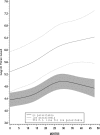Malaria parasitemia and CD4 T cell count, viral load, and adverse HIV outcomes among HIV-infected pregnant women in Tanzania
- PMID: 20348498
- PMCID: PMC2844563
- DOI: 10.4269/ajtmh.2010.09-0477
Malaria parasitemia and CD4 T cell count, viral load, and adverse HIV outcomes among HIV-infected pregnant women in Tanzania
Abstract
We examined the cross-sectional relationships between malaria parasitemia and CD4 T cell count and viral load among human immunodeficiency virus (HIV)-infected pregnant women. We then followed women to investigate whether or not baseline parasitemia predicted CD4 T cell counts or viral loads > 90 days post-baseline or predicted time to HIV disease stage 3 or 4 or acquired immune deficiency syndrome (AIDS)-related death (ARD). Parasitemia level was nonlinearly associated with viral load at baseline and among measurements taken > 90 days post-baseline; women with low baseline parasitemia, versus none, had higher viral loads at both time points. Any baseline parasitemia predicted an increased rate of ARD among women with baseline CD4 T cell counts > or = 500 cells/microL (ratio rate [RR] = 2.6; 95% confidence interval [CI] = 1.1-6.0; P test for heterogeneity = 0.05). Further study is warranted to determine whether or not parasitemia is especially detrimental to individuals with lower levels of immunosuppression or chronic low parasitemia.
Figures
Similar articles
-
Effects of HIV-1 serostatus, HIV-1 RNA concentration, and CD4 cell count on the incidence of malaria infection in a cohort of adults in rural Malawi.J Infect Dis. 2005 Sep 15;192(6):984-91. doi: 10.1086/432730. Epub 2005 Aug 12. J Infect Dis. 2005. PMID: 16107950
-
Association of immune complexes and plasma viral load with CD4+ cell depletion, CD8+ DR+ and CD16+ cell counts in HIV+ hemophilia patients. Implications for the immunopathogenesis of HIV-induced CD4+ lymphocyte depletion.Immunol Lett. 2001 Mar 1;76(2):69-78. doi: 10.1016/s0165-2478(01)00181-x. Immunol Lett. 2001. PMID: 11274723
-
CD4 count, viral load and parasite density of HIV positive individuals undergoing malaria treatment with dihydroartemisinin in Benin City, Edo state, Nigeria.J Vector Borne Dis. 2007 Jun;44(2):111-5. J Vector Borne Dis. 2007. PMID: 17722864
-
HIV and malaria.AIDS Rev. 2007 Apr-Jun;9(2):88-98. AIDS Rev. 2007. PMID: 17694676 Review.
-
[Impact of malaria on HIV infection].Med Mal Infect. 2010 May;40(5):256-67. doi: 10.1016/j.medmal.2009.10.008. Epub 2009 Nov 29. Med Mal Infect. 2010. PMID: 19951829 Review. French.
Cited by
-
Malaria and HIV coinfection in sub-Saharan Africa: prevalence, impact, and treatment strategies.Res Rep Trop Med. 2018 Jul 27;9:123-136. doi: 10.2147/RRTM.S154501. eCollection 2018. Res Rep Trop Med. 2018. PMID: 30100779 Free PMC article. Review.
-
The Impact of HIV Coinfection on Cerebral Malaria Pathogenesis.J Neuroparasitology. 2012;3:235547. doi: 10.4303/jnp/235547. Epub 2012 Mar 2. J Neuroparasitology. 2012. PMID: 22545215 Free PMC article.
-
Malaria prevalence in HIV-positive children, pregnant women, and adults: a systematic review and meta-analysis.Parasit Vectors. 2022 Sep 14;15(1):324. doi: 10.1186/s13071-022-05432-2. Parasit Vectors. 2022. PMID: 36104731 Free PMC article.
-
Spatial overlaps in the distribution of HIV/AIDS and malaria in Zimbabwe.BMC Infect Dis. 2018 Nov 27;18(1):598. doi: 10.1186/s12879-018-3513-y. BMC Infect Dis. 2018. PMID: 30482166 Free PMC article.
-
Tissue Parasites in HIV Infection.Curr Infect Dis Rep. 2019 Nov 16;21(12):49. doi: 10.1007/s11908-019-0703-8. Curr Infect Dis Rep. 2019. PMID: 31734888 Review.
References
-
- World Health Organization, UNAIDS 2008Towards Universal Access: Scaling Up Priority HIV/AIDS Interventions in the Health Sector, Progress Report Available at: http://www.unaidsrstesa.org/userfiles/file/towards_universal_access_repo... Accessed March 7, 2009
-
- World Health Organization 2008Antiretroviral Therapy for HIV Infection in Adults and Adolescents: Recommendations for a Public Health Approach, 2006 Revision Available at: http://www.who.int/hiv/pub/guidelines/artadultguidelines.pdf Accessed March 7, 2009 - PubMed
-
- Holmes CB, Losina E, Walensky RP, Yazdanpanah Y, Freedberg KA. Review of human immunodeficiency virus type 1-related opportunistic infections in sub-Saharan Africa. Clin Infect Dis. 2003;36:652–662. - PubMed
-
- French N, Nakiyingi J, Lugada E, Watera C, Whitworth JA, Gilks CF. Increasing rates of malarial fever with deteriorating immune status in HIV-1-infected Ugandan adults. AIDS. 2001;15:899–906. - PubMed
-
- Ladner J, Leroy V, Simonon A, Karita E, Bogaerts J, De Clercq A, Van De Perre P, Dabis F. HIV infection, malaria, and pregnancy: a prospective cohort study in Kigali, Rwanda. Am J Trop Med Hyg. 2002;66:56–60. - PubMed
Publication types
MeSH terms
Grants and funding
LinkOut - more resources
Full Text Sources
Medical
Research Materials


